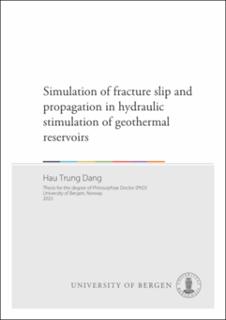Simulation of fracture slip and propagation in hydraulic stimulation of geothermal reservoirs
Doctoral thesis

Åpne
Permanent lenke
https://hdl.handle.net/11250/3086196Utgivelsesdato
2023-09-01Metadata
Vis full innførselSamlinger
Sammendrag
Rollen til hydraulisk stimulering i å øke produksjonen fra geotermiske reservoarer, og muliggjøre kommersiell utnyttelse av et større spekter av geotermiske ressurser, har fått økt oppmerksomhet de siste tiårene. Under stimulering kan eksisterende sprekker sideforskyves, forplante seg og koble seg til andre sprekker og der igjennom øke permeabiliteten i reservoaret. Prosessene er preget av sterke hydromekaniske interaksjoner, som vi har begrensede muligheter til å overvåke. Numeriske simuleringer er derfor et viktig verktøy for å hjelpe oss til å bedre forstå mekanismene som er i spill.
Avhandlingen tar sikte på å utvikle en omfattende matematisk modell og en numerisk tilnærming for å analysere bruddmekanismer og undersøke koblede hydromekaniske prosesser som forekommer i oppsprukne porøse medier. Den foreslåtte modellen benytter en blandet-dimensjonal konseptuell modell, som inkluderer porelastisitet i det porøse mediet og kontaktmekanikk for sprekkene. Modellen tillater også forplantning og koalescens av eksisterende sprekker.
Et nytt diskretiseringsskjema for å løse den foreslåtte matematiske modellen presenteres. Den foreslåtte metoden bruker en to-nivå simuleringstilnærming, kategorisert i grove og fine nivåer, for å redusere beregningskostnader og sikre nøyaktighet. En endelig volummetode kombineres med en aktiv-sett løsningsstrategi for å diskretisere porelastisitet og bruddkontaktmekanikk på det grove nivået. Sprekkeforplantning betraktes på et fint nivå, der en endelig elementmetode kombineres med kollapsede kvartpunktselementer for å approksimere singulariteten i spenningen ved enden av sprekkene. Adaptiv gitring basert på en feilestimator og Laplace-glatting av gitteret introduseres på begge nivåer for effektivt å håndtere sprekkepropagering og koalescens. Simuleringene utført i denne avhandlingen forbedrer vår forståelse av hydraulisk stimulering og dens effekt på forbedring av sprekkepermeabilitet og konnektivitet i geotermiske reservoarer. The role of hydraulic stimulation in enhancing geothermal reservoir production and allowing for commercial exploitation of a larger range of geothermal resources has attracted attention from researchers in recent decades. During stimulation, preexisting fractures may slip, propagate, and connect to other fractures to enhance permeability. The processes are characterized by strong hydromechanical interactions, which have limited monitoring opportunities. Therefore, numerical simulations provide a powerful tool to help us better understand the mechanisms.
This thesis aims to develop a comprehensive mathematical model and a numerical approach to analyze fracture mechanisms, and to investigate the coupled hydromechanical processes occurring in fractured porous media. The proposed model will employ a mixed-dimensional conceptual model, incorporating the concepts of poroelasticity and fracture contact mechanics. The model will also allow for the growth and coalescence of preexisting fractures.
A novel discretization scheme for solving the proposed mathematical model is presented. The proposed scheme employs a two-level simulation approach, categorized into coarse and fine levels, to reduce the computational costs and ensure accuracy. A finite volume method is combined with an active set strategy to discretize poroelasticity and fracture contact mechanics on the coarse level. Fracture propagation is considered on a fine level, in which a finite element method is combined with collapsed quarter-point elements to capture the stress singularity at the fracture tips. Adaptive remeshing based on an error estimator and Laplacian smoothing is introduced on both levels to effectively capture fracture propagation and coalescence in the computational grid. The simulations conducted in this thesis improve our understanding of hydraulic stimulation and its effect on enhancing fracture permeability and connectivity in geothermal reservoirs.
Består av
Paper A: Numerical investigation of wing crack initiation and propagation due to shear slip. Hau Trung Dang, Eirik Keilegavlen, Inga Berre. In: Proceedings of European Geothermal Congress, 11-14 June 2019, Den Haag, The Netherlands. The article is available in the thesis file.Paper B: Numerical modeling of wing crack propagation accounting for fracture contact mechanics. Hau Trung Dang, Eirik Keilegavlen, Inga Berre. International Journal of Solids and Structures. Vol. 204–205: 233-247. 2020. The article is available at: https://hdl.handle.net/11250/2754008
Paper C: Two-level simulation of injection-induced fracture shear deformation and wing-crack propagation in poroelastic media. Hau Trung Dang, Eirik Keilegavlen, Inga Berre International Journal of Rock Mechanics and Mining Sciences. Vol. 160, 105248. 2022. The article is available at: https://hdl.handle.net/11250/3060752
Paper D: Modeling of mixed-mechanism stimulation for the enhancement of geothermal reservoirs. Hau Trung Dang, Eirik Keilegavlen, Inga Berre. The article is available in the thesis file.